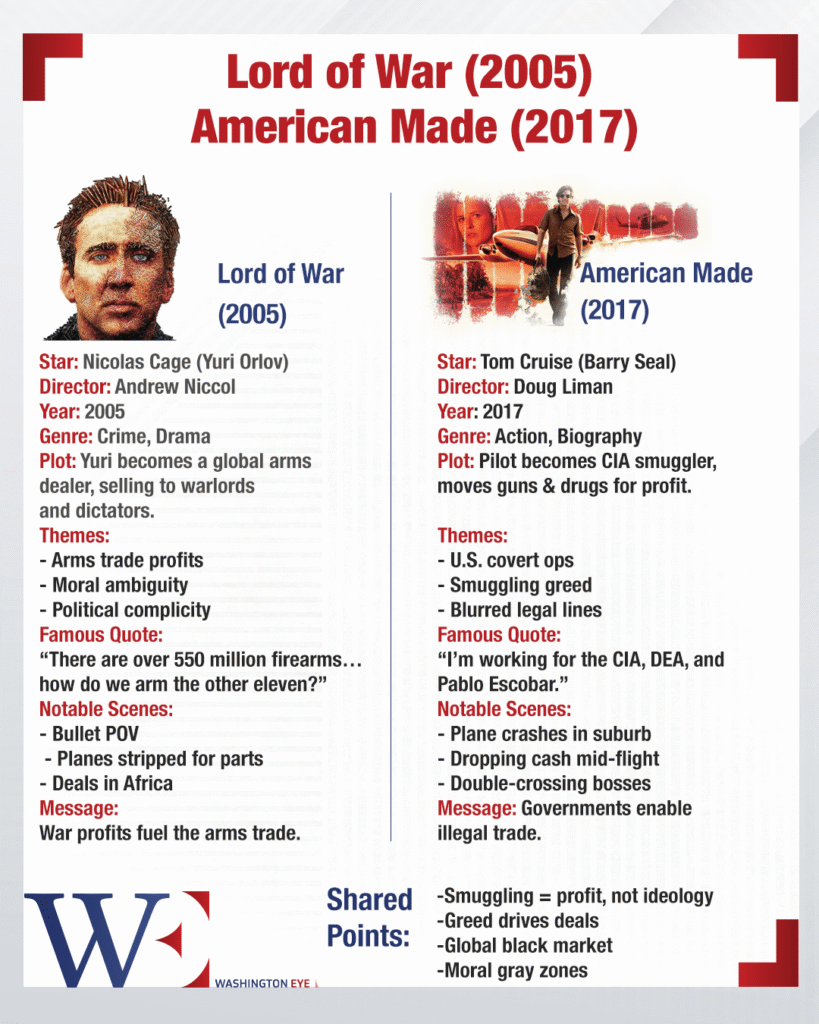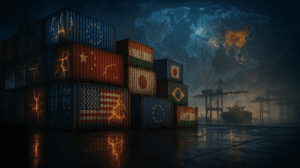When U.S. troops scrambled out of Afghanistan in August 2021, the world watched footage of helicopters leaving the embassy rooftop, desperate crowds at Kabul airport, and the Taliban streaming into the capital. But what went largely unnoticed in those chaotic final days was the real treasure left behind — nearly one million weapons and military gear, from M4 rifles to Humvees, night-vision goggles to ammunition stockpiles.
And just like a scene from Lord of War or American Made, those weapons didn’t sit idle for long.
In the 2017 film American Made, Tom Cruise plays Barry Seal, a TWA pilot turned CIA smuggler, ferrying guns to Central America — not out of political conviction, but for cold, hard cash. It’s a story about how war and profit intertwine, where ideology takes a backseat to opportunity. Fast forward to Kabul, and the same principle applies: weapons abandoned by U.S. forces were never about ideology for those who grabbed them — they were about profit.
According to a UN Security Council briefing held behind closed doors in Doha, Taliban representatives admitted that nearly half a million of those weapons are “unaccounted for.” Independent analysis confirms the scale of the loss. While Taliban fighters posed with captured U.S. rifles and Humvees for propaganda, the real action was unfolding quietly, in back rooms and encrypted chats, where weapons were being sold to the highest bidder.
The arms didn’t stay in Afghanistan. They spread — like oil on water — into Pakistan, Uzbekistan, Yemen, and beyond. A February 2024 UN report listed militant buyers including Tehreek-e-Taliban Pakistan (TTP), the Islamic Movement of Uzbekistan, and Yemen’s Houthi rebels. But in truth, the guns traveled not because of shared extremist causes, but because they were lucrative commodities.
Just like Barry Seal’s contraband flights, the black market arms trade is first and foremost a business.
That reality has surfaced in seizures across the region. In July 2023, Syrian authorities intercepted a large shipment of weapons bound for Sweida — a flashpoint for militia activity. Though the origins of the shipment weren’t officially revealed, independent analysts spotted U.S.-manufactured serials and models tracing back to Afghan stockpiles. Meanwhile, in Saudi Arabia, customs agents announced a stunning bust: narcotics, tobacco, and weapons seized in a single convoy, blending arms smuggling with broader illicit trades.
In Lebanon, security forces arrested smugglers attempting to sneak guns across the porous Syrian border. And perhaps most tellingly, UAE authorities foiled a plot to transfer weapons and military equipment to Sudanese armed factions, where civil war rages. All these shipments were part of a murky transnational web — not driven by ideology, but by profit motives as old as war itself.
It’s an uncomfortable truth often glossed over in policy debates: most arms smuggling isn’t ideological. It’s transactional.
In Lord of War, Nicolas Cage’s character Yuri Orlov delivers a chilling monologue: “There are over 550 million firearms in worldwide circulation. That’s one firearm for every twelve people on the planet. The only question is: how do we arm the other eleven?” The Taliban may not have seen themselves as arms dealers, but by sitting on an arsenal of American-made firepower, they had a seller’s advantage.
Indeed, Taliban commanders were reportedly allowed to keep up to 20% of captured U.S. arms for “personal use.” But personal use soon turned into personal sales. By 2022, weapons that had once been openly hawked in Kandahar’s famous arms bazaars were moving quietly through WhatsApp and Telegram groups, where encryption provided a safe marketplace. Buyers? Not just Afghan factions, but foreign militias willing to pay premium prices.
Taliban spokesman Hamdullah Fitrat denies smuggling allegations, insisting all weapons remain “securely stored.” But visuals tell a different story: from fighters holding M4 rifles in Yemen to U.S.-origin Humvees appearing in Sudanese desert convoys.
The U.S. Special Inspector General for Afghanistan Reconstruction (SIGAR) admits it lost track of most of the equipment due to years of inconsistent tracking and poor coordination between agencies. John Sopko, the former SIGAR chief, warned that trying to retrieve the weapons was now “next to impossible.” Meanwhile, former President Donald Trump has harped on a figure of $85 billion in lost military gear — a figure inflated to include salaries and infrastructure, but nonetheless politically potent.
Still, beyond the political posturing, a deeper pattern is emerging: the U.S. inadvertently stocked the world’s most dangerous flea market.
And like the smuggling depicted in American Made — where government-sanctioned operations morph into rogue profiteering — the line between war spoils and illicit arms deals became blurred. While policy makers framed Afghanistan’s collapse in terms of governance and security, smugglers framed it in terms of supply and demand.
The weapons didn’t leave Afghanistan because of ideology. They left because buyers were ready, routes were open, and sellers — whether Taliban or corrupt commanders — saw an opportunity to cash in.
Some arms ended up reinforcing ideological battles: in the hands of al-Qaeda affiliates, or militias fighting for sectarian causes. But many more likely wound up with whoever paid in cash, gold, or trade goods. In the black market, the creed isn’t jihad or nationalism; it’s profit margin.
That reality complicates international responses. How do you disrupt a trade that’s decentralized, entrepreneurial, and thriving on encrypted platforms? Unlike Cold War arms pipelines that followed state allegiances, today’s flows are opportunistic, nimble, and pragmatic. A broker in Kandahar sells to a Yemeni smuggler, who offloads to a Sudanese militia, no questions asked.
For regional powers like Saudi Arabia, the UAE, and Egypt, the concern isn’t just that terrorists get weapons. It’s that anyone — a warlord, a cartel, a political rival — can suddenly become a militarized actor with U.S.-grade firepower.
As shipments continue to be seized from Syria to Sudan, one thing is clear: the Afghan arsenal is now a regional stockpile for whoever pays. And like the arms runners of Lord of War or American Made, those moving the weapons don’t necessarily care what the guns will be used for — only what they’re worth.
It’s a cautionary tale echoing through history: wars end, but weapons linger, traded and resold, long after the flags change and the treaties are signed. Afghanistan’s abandoned stockpile is the latest chapter in that grim tradition.
And somewhere, in a dusty backroom or a WhatsApp chat, a middleman counts cash over a crate of American rifles, unconcerned whether they’ll fuel a jihad, a coup, or just the next black-market deal.



















